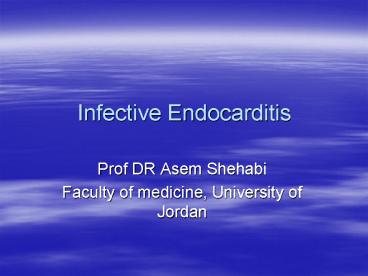Infective Endocarditis PowerPoint PPT Presentation
Title: Infective Endocarditis
1
Infective Endocarditis
- Prof DR Asem Shehabi
- Faculty of medicine, University of Jordan
2
Infective endocarditis-1
- Fever of unknown origin.. Common cause of
Infective Endocarditis..Inflammation of the
endocardium.. inner of the heart muscle..
associated with the epithelial lining of heart
valves .. It is caused by a wide variety of
bacteria ..rarely a fungus or virus. - Defensive immune mechanisms..WBCs cannot directly
reach the valves via the bloodstream. - If any organism attaches to a valve surface and
forms a vegetation, the host immune response will
be inhibited. - The lack of blood supply to the valves also has
implications on treatment, since antimicrobial
drugs have difficulty reaching the infected valve.
3
2/
- The incidence of infective endocarditis in a
general population has been estimated between 2-6
cases per 100,000 patient/ year, - It is higher in patients with underlying
congenital valvular heart disease.. intravenous
drug abuse .. invasive surgery oral dental
procedures. - All invasive procedures may cause blood stream
infections and result in acute or subacute
endocarditis.
4
3/
- Historically, rheumatic disease ..Group A
Streptococci was considered a frequent
pre-disposing factor for endocarditis. - Prosthetic valvular heart disease accounts for
about 1/3 of all cases of endocarditis, and
occurs in 1 to 3 of patients after valvular
heart surgery. - Any damage in heart valves induce formation of
endocarditic vegetation .. involving bacteria,
platelets, fibrin and few leucocytes, and is
considered a special kind of biofilm
5
4/
- Acute endocarditis followed bacteremia..mostly
S. aureus ..Bacteria cells settle on normal or
deformed heart valves.. Multiply, Interact
cause rapid destruction ..Fatal cardiac failure..
days-weeks. - Subacute endocarditis .. often developed by
presence abnormal valves.. congenital deformities
rheumatic lesions.. slowly .. caused by few
Gram-positive cocci.. mostly Strept. Viridans
causing first subacute bacteremia..Low fever
other symptoms.
6
Predisposing Factors for Endocarditis
- Congenital heart disorders.. Prosthetic heart
valves - Periodontal procedures
- Dental extractions, Dental implants
- Tonsillectomy , Esophageal dilation
- Skin infections.. Intravenous drug users
- Cystoscopy.. Urethral dilation, Colonoscopy,
- All these procedures.. associated with Commensal
flora.. Endogenous infections. - Antibiotic Prophylaxis is recommended.
7
Microbial Causes-1
- Gram-positive cocci.. facultative anaerobes,..
occur as chains/clusters or pairs .. Catalaseve
/Staphylococci group, catalase-ve/ Streptococci
Enterococci groups. - Streptococci are subdivided into groups
according their hemolytic reaction on blood agar
in vitro by serotypes surface cell wall
specific carbohydrate antigens. - Viridans streptococci.. Normal oral-intestinal
flora.. Common causes of dental caries.. Oral
abcesses.. do not possess a specific carbohydrate
antigens.. Carry certain M protein types
8
Microbial Causes-2
- Viridans streptococci Group.. Deposit dextran,
adhesins, Fibronectin-binding protein. - Group A Streptococci (S. pyogenes).. Repeat Sore
throat infection.. Less skin infection.. Develop
Pos-streptococcal Diseases ..Rheumatic heart
disease.. Children..observed in Jung adults. - Virulence substance M-protein (80 types) ..Cell
wall antigens associated M-protein cross-react
with the cardic muscle tissues.. causing damage
.. can be responsible for rheumatic myocarditis..
M-protein Type Specific Antibodies is protecting
host to some extent.
9
Group A Hemolytic Streptoccci group
10
Microbial Causes-3
- Responsible for the largest percentage of cases
(30-40).. Certain species Viridans streptococci,
like S. mitis, S. mutans account for 10 of
cases, and tend to be less susceptible to
penicillin. - Enterococcus species ( E. fecalis, E. faecium)
are responsible for up to 5-10 of cases some
strains may be resistant to penicillin, and to
vancomycin. - The treatment of choice for infections caused by
Viridans streptococci is still penicillin, and
vancomycin or teicoplanin
11
Streptococci-Staphyloccoci
12
Microbial Causes-5
- S. aureus is a common cause of endocarditis, may
result in a severe sepsis syndrome with a fatal
outcome. - Metastasis staphylococci foci spread to the
brain, lungs, liver, and kidneys. These
complications result in a very high mortality
rate. - Most endocarditis cases occurred within 2-month-1
year year following surgery.. contamination by
skin bacteria. - Infections from vascular catheters surgical
wounds are more frequent sources of infection.
13
Infective agents of Native Valve Endocarditis
Cases Organisms
30-40 Streptococcus viridans
5-10 Enterococcus species
10-25 Other streptococci
10-25 / 1-3 Staphylococcus aureus / Coagulase-negative staphylococci
2-13 Gram-negative bacilli Brucella, Salmonella
2-4 Fungi (Candida), Aspergillus
5 Others
14
Microbial Causes-6
- A group of fastidious gram-negative bacteria can
cause endocarditis Gram-ve bacteria Brucella,
Salmonella, Haemophilus, Cardiobacterium,
Eikenella, Gramve Actinobacillus. - Clinically, these bacteria spp. causing subacute
or chronic course, and often present with embolic
lesions from large vegetations in herat valves . - Most cases of fungal endocarditis occur in
patients who are receiving prolonged antibiotics
or parenteral nutrition through central vascular
catheters.. Immuno-compromised patients.
15
Yeast Filamentous Fungi
- The most common species is Candida albicans,
followed by other Candida spp. ( C. glabrata, C.
krusei, C. tropicals).. - Common bacterial Normal flora..
Oral-intestinal-Urinary tract (Vagina)..
Infection often followed often using catheters or
respiratory intubation. - Endocarditis due to Histoplasma capsulatum or
Aspergillus species is very rare..
Immuno-supressed patients.
16
Candida albicans Pseudohyphae
17
Diagnosis Treatment
- Clinical Diagnosis is usually suspected based
upon the patient's history, symptoms, and
findings such as a new murmur.. Fever. - Echocardiogram.. Ultrasound study of the heart
muscle and valves may be helpful in identifying a
clump of bacteria on the heart valve. - Suspected Endocarditis ..Collect 3 blood for
culture.. within 1-2 days.. Before treatment with
antibiotics - Culture first for bacteria.. second for fungi if
treatment with antibiotic failed
18
2/
- About 10-50 of patients with clinically-suspected
endocarditis will have negative blood cultures
for any organism..Previous antibiotic treatment. - Select antibiotic treatment according type of
bacteria susceptibility test. - Antibiotic therapy must continue for at least a
month.. Most patients respond rapidly to
appropriate antibiotics and becoming without a
fever within one week.

